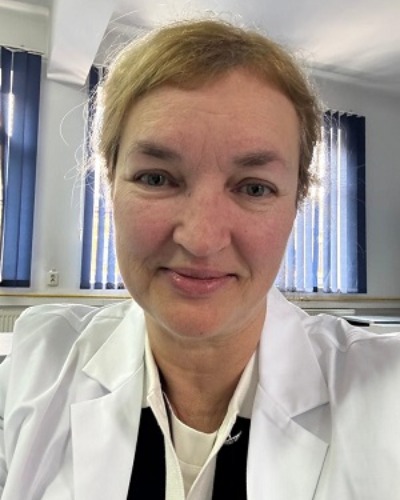Refine the list (min. 2 characters)
Keynote Presentation (In-Person)

Title: Eliminating implant failure in humans: 30,000 cases and counting
Nanomedicine is the use of nanomaterials to improve disease prevention, detection, and treatment which has resulted in hundreds of FDA approved medical products. While nanomedicine has been around for several decades, new technological advances are pushing its boundaries. For exa [....] » Read More
Keynote Presentation (In-Person)

Title: Traumatic brain injury, whats new?
Definition and Types: TBI is an injury to the brain caused by external force, resulting in a range of effects. It can be classified as mild (concussions), moderate, or severe based on symptoms and impact. Causes: Common causes include falls, vehicle accidents, sports in [....] » Read More
Keynote Presentation (In-Person)

Title: Neurobiology of Addiction
Addiction was historically viewed as a disease of “weak personality” and was not systematically addressed by the scientific and medical communities until the latter half of the 20th century. They are now commonly accepted as diseases of the brain caused by the i [....] » Read More
Keynote Presentation (Virtual)

Historical: Before WWII the great majority of patients with acute traumatic spinal cord injuries died within a year or two from injury. However for many decades prior to WWII there was no shortage of Physicians and Surgeons experimenting with the management of the injured spin [....] » Read More
Keynote Presentation (Virtual)

Objective: To investigate the effect of and Acupuncture on brain plasticity and motor development in children with cerebral palsy. Investigate effect on mechanism of apoptosis of brain nerve cells, regulating the expression of neurotrophic factors, promoting the remodeling of ner [....] » Read More
Oral Presentation (In-Person)

Physical exercise is known to reduce depression, but the underlying brain mechanisms SAMPLE ABSTRACT TEMPLATE remain unclear. Based on a chronic restraint stress model in mice, we showed that 4-week treadmill exercise profoundly maintained normal neural activity in the nucl [....] » Read More
Oral Presentation (In-Person)

Title: Bio-RECURSION or DNA-comp and Brain-BLOCKCHAIN as nerves nets by GENES
In the last decade, a radically different scientific concept of developing Life on Earth as Bio-RECURSION, or Neuro-BLOCKCHAIN - has emerged. From the point of view of this concept, Life is Evolutional formation of Closed-Loop Coding-Decoding (CL-CD) chem-matter (bio-chem) proced [....] » Read More
Oral Presentation (In-Person)

Title: Traumatic Millard-Gubler syndrome: Case report
Introduction: Millard-Gubler syndrome is caused by a lesion in the ventral and caudal area of the pons, with a clinical manifestation of an alternating brainstem syndrome, characterized by paralysis of the sixth and seventh cranial nerves on the side of the lesion and contralater [....] » Read More
Oral Presentation (In-Person)

Title: Poland syndrome combined with facial palsy: A case report
Poland Syndrome is a congenital malformation marked by incomplete development or absence of the pectoralis major muscle on unilateral side of the chest, typically associated with abnormalities in the ipsilateral upper limb (1). The most accepted explanation is that, around the si [....] » Read More
Oral Presentation (In-Person)

Title: Analysing human behaviour and health by means of a large-area capacitive sensor floor
People are in almost constant contact with the floor throughout the day. With high-resolution sensors discreetly installed under the floor covering, data on the number, location, direction of movement, and speed of individuals can be recorded continuously. In addition to detectin [....] » Read More
Oral Presentation (In-Person)

Title: Psychological challenges in burn patients
With the increased survival of patients with large burns comes a new focus on the psychological challenges and recovery that such patients must face. Most burn centres employ social workers, vocational counsellors, and psychologists as part of the multidisciplinary burn team. Phy [....] » Read More
Oral Presentation (In-Person)

Title: Neurotropic and biophysics effects of Kyokushin Karate kata
Introduction. In Eastern martial arts, non-contact mental influence on a partner is described, often associated with the concept of "energy-informational exchange." The Kyokushin Karate Kata (KKK) practice is particularly noteworthy in this context. Objective. To exp [....] » Read More
Oral Presentation (In-Person)

Title: Migraine and oxidative stress
Migraine is a chronic neurovascular disorder characterized by acute, debilitating attacks, posing a significant public health challenge. The severity and duration of pain, along with the limited effectiveness of treatments for some patients, underscore the ongoing need for resear [....] » Read More
Oral Presentation (In-Person)

Title: A filipino child presenting with primrose syndrome with a deletion on the zbtb20 gene variant
Background: Intellectual disability in association with congenital anomalies affects 1-3% of the population, and due to its diversity, diagnosis can be challenging. Primrose syndrome is one of these rare genetic conditions that present with such disability and anomalies. It [....] » Read More
Oral Presentation (In-Person)

Title: A way to use computers to figure out how chemical pathways affect brain function on a large scale
The study introduces a computational method for brain simulations using mean-field models with biophysical foundations, focusing on membrane conductances and synaptic receptors. It demonstrates that anesthetics targeting GABAA and NMDA receptors can cause brain changes to general [....] » Read More
Oral Presentation (In-Person)

Title: A highly stable monomeric red fluorescent protein for advanced microscopy
The stability of fluorescent proteins (FPs) is crucial for many imaging techniques, including long-term. live cell imaging, super-resolution microscopy, correlative light and electron microscopy (CLEM), and tissue clearing. Although several stable green and yellow FPs are availab [....] » Read More
Oral Presentation (In-Person)

Title: The disease of sympathetic overdrive--A forgotten neurological disease?
The sympathetic nervous system participates in the functional regulation of numerous tissues and organs; its long-term excessive activation is closely associated with many related disorders. However, to date, the understanding of this symptom has been fragmented. The disease of s [....] » Read More
Oral Presentation (In-Person)

BACKGROUND: APOE ε4 is the strongest genetic risk factor for Alzheimer’s disease (AD), with homozygous carriers (ε4/ε4) experiencing accelerated cognitive decline. While its role in amyloid and tau pathology is established, its impact on retinal and [....] » Read More
Oral Presentation (In-Person)

Neurodevelopmental disorders (NDDs) represent a significant public health challenge worldwide, and Saudi Arabia is no exception. With a unique population structure characterized by high rates of consanguinity, the Saudi population presents a distinct genetic landscape for NDDs. I [....] » Read More
Oral Presentation (In-Person)

The purpose of the current research was to investigate the effectiveness of the cognitive training course based on the key cognitive factors for improving manager's performance. 30 managers in an organization in Tehran selected and randomly assigned to either the cognitive tr [....] » Read More
Oral Presentation (In-Person)

The crosstalk between autophagy and apoptosis is one of the most important processes involved in the cell program death, and several mechanisms including oligodendrocyte apoptosis and autophagy play significant roles in activating macrophages, microglial cells, and finally demyel [....] » Read More
Oral Presentation (In-Person)

Peripheral nerve injuries (PNIs) remain a significant neurological hurdle, with clinical manifestations varying based on the degree of axonal disruption. While progress has been made in understanding the underlying mechanisms of nerve damage and regeneration, achieving full funct [....] » Read More
Oral Presentation (Virtual)

Title: Managing the transformation towards intelligent and ethical health and social care ecosystems
Healthcare systems around the world are undergoing an organizational, methodological and technological transformation towards personalized, preventive, predictive, participative precision (5P) medicine ecosystems. These ecosystems consider individual health status, conditions, ge [....] » Read More
Oral Presentation (Virtual)

Title: Trisomy21/Down’s syndrome : From main chromosome 21 genes to potential future therapies
Trisomy 21 affects around 5 000 000 persons worldwide. The persons born with trisomy 21 have very different phenotypes according to their parental genes, to the way they are breeding and educated. The life expectancy of these persons is around 65 years in developped cou [....] » Read More
Oral Presentation (Virtual)

Title: Refine Carpal Tunnel Syndrome (CTS) nerve conduction grading tool with case presentation
Background: The severity of carpal tunnel syndrome (CTS) may be categorized in a number of ways utilizing one of a range of presently available grading tools. Detail grading system explained in this paper with case presentation. The aim of this research is to establish, u [....] » Read More
Oral Presentation (Virtual)

Mental health restoration is critically important, especially in war and constant socio-economic stress times. Military conflicts seriously affect the psychological state at the individual-collective level. Occupation, which is often accompanied by torture, abuse, forced isolatio [....] » Read More
Oral Presentation (Virtual)

Objective: To evaluate the efficacy of perivascular sympathectomy in managing long-segment tubular stenosis of the cervical segment (C1) internal carotid arteries (ICAs) accompanying Grade 2 or 3 kinking distally. Due to the lesion's deep and distal location, conventional med [....] » Read More
Oral Presentation (Virtual)

Objective: This retrospective study examines the impact of microsurgical treatment on vertebral artery (VA) dolicoarteriopathies and associated restless leg syndrome (RLS) in patients with refractory vertebrobasilar insufficiency (VBI). Patients and Methods: We analyzed 78 patien [....] » Read More
Oral Presentation (Virtual)

Title: Recovery-oriented treatments in chronic mental health disorders
Background: The rehabilitation and reintegration of patients with chronic mental health disorders is achieved solely through a combination of evidence-based interventions, namely pharmacotherapy and cognitive behavioral psychotherapy, and rehabilitation aimed at recovery. &nbs [....] » Read More
Oral Presentation (Virtual)

Title: Lysosomes, autophagy in brain cells of db/db mice with experimental diabetes
Lysosomes, autophagy in brain cells of db/db mice with genetic model of diabetes. Diabetes T2 is connected with forming of neurodegeneration development, especially in ageing. These changes include some symptoms of Alzheimer disease (AD), mechanism of their development were not s [....] » Read More
Oral Presentation (Virtual)

Background: Malignant cerebral edema (MCE) is a major cause of mortality and disability in acute ischemic stroke, yet effective treatments remain limited. Identifying specific biomarkers for early prediction and therapeutic guidance of MCE is an ongoing clinical challenge. [....] » Read More
Oral Presentation (Virtual)

Title: The association between adverse childhood experiences and neuroplastic pain in adults
Background: This study aimed to explore the association between adverse childhood experiences (ACEs) and neuroplastic musculoskeletal pain in adults, using the ACEs scale and the PPDA (psychophysiologic disorder) symptom checklist, and assess the extent to which ACEs predict PPDA [....] » Read More
Oral Presentation (Virtual)

Title: Effects of bilingualism on cognitive inhibition and academic achievement in school-aged children
Bilingualism refers to the ability to use two languages functionally. This study investigated the impact of bilingualism on cognitive inhibition and academic performance in 110 children aged 8 to 12, divided into bilingual and monolingual groups. Inhibitory control was assessed u [....] » Read More
Oral Presentation (Virtual)

INTRODUCTION: The brain is the least organ monitored during surgery, especially cardiac surgery. Perioperative brain injury frequently occurs especially during cardiac surgery, and the use of one or more brain monitoring tools may help in early detection of brain injury, which al [....] » Read More
Oral Presentation (Virtual)

Dyslexia is a reading disability that is characterized by when an individual has trouble in rapid and accurate word decoding. This study developed, piloted and assessed the validity and reliability of three instruments: Rapid Automatized Scale (RANS), Arabic Reading Ability Scale [....] » Read More
Oral Presentation (Virtual)

Epilepsy is a chronic neurological disorder characterized by recurrent, unprovoked seizures caused by abnormal, excessive electrical activity in the brain. In this study, a rat model of epilepsy was established to evaluate behavioral, pathological, and molecular alterations, with [....] » Read More
Oral Presentation (Virtual)

Title: Intraoperative neurophysiological monitoring of a 3-day-old infant
A successful surgery was performed for the first time on a 3-day-old infant weighing 3 kg with congenital myelomeningocele (MMC) in the cervicothoracic region with complete neuromonitoring (IONM) of the upper and lower extremities using MEP, SEEP and EMG modes with 18 pairs of el [....] » Read More
Poster Presentation (In-Person)

Title: Pediatric neurodegenerative disorders and anesthesia considerations
Pediatric neurodegenerative disorders encompass a wide range of conditions that result from progressive damage to cells and nervous system connections that are essential for mobility, coordination, strength, sensation, and cognition. Neurodegenerative diseases affect millions of [....] » Read More
Poster Presentation (In-Person)

INTRODUCTION Stroke is defined as a syndrome of acute, focal neurological deficit attributed to a vascular injury to a part of the brain which can either be due to infarction or hemorrhage. Brainstem stroke is considered the most lethal form of all strokes accounting for a sig [....] » Read More
Poster Presentation (In-Person)

White matter hyperintensities (WMHs) are a prominent neuroimaging feature in Alzheimer’s disease (AD), but their relationship with plasma biomarkers, cognitive decline, and genetic factors like APOE ε4 remains poorly understood. This study investigates WMH volumes, [....] » Read More
Poster Presentation (In-Person)

Title: Facial motor evoked potential with paired transcranial magnetic stimulation for hemifacial spasm
Objective: Microvascular decompression (MVD) is widely considered the treatment of choice for hemifacial spasm (HFS), but not all patients immediately benefit from it. Numerous electrophysiological tests have been employed to monitor the integrity of the facial nerve prior to, du [....] » Read More
Poster Presentation (In-Person)

Background: Reminiscence therapy is a widely used non-pharmacological approach for improving emotional well-being in older adults, particularly those with neurodegenerative diseases. While both autobiographical and collective memories can be therapeutic, little is known about [....] » Read More
Poster Presentation (In-Person)

Molecular docking is widely used in the assessment of the therapeutic potential of pharmaceutical agents. The binding properties of beta-carotene (BC) to acetylcholine esterase (AChE) proteins were characterized using the molecular docking method. The mechanism of AChE inhibition [....] » Read More
Poster Presentation (In-Person)

Parkinsonism- hyperpyrexia syndrome (PHS) could turn out to be a fatal neurological emergency that mimics neuroleptic malignant syndrome (NMS). It presents as acute systemic inflammatory response syndrome, worsening of rigidity, fever, autonomic symptoms, confusion with high LDH [....] » Read More
Poster Presentation (In-Person)

Title: An approach of automating hippocampal volumetric tool for brain
Alzevita is a cloud-based AI tool developed to assist neuroradiologists and imaging professionals in brain MRI analysis through automated hippocampal segmentation and volumetric reporting. It provides improved consistency, speed, and clinical confidence in quantitative neuroimagi [....] » Read More
Copyright 2024 Mathews International LLC All Rights Reserved
